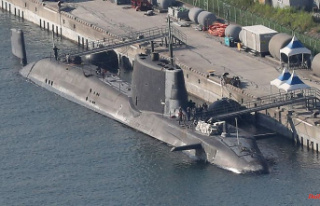Many drugs are simply shipped from one place to another in packages. The senders try to avoid drug detection dogs and customs with distracting smells or idiosyncratic packaging. Experienced officials will still find what they are looking for.
It's late at night when customs officer Jens Ahland holds a package that supposedly contains wall decorations. On the box is a black, oddly bumpy cross with "Love" painted on it in cheesy writing. One could argue that the shocking tastelessness of the container could already be punishable. But Ahland, a towering man in a correctly fitting short-sleeved shirt, has a different hunch. "Hash paste," he notes. "Now don't ask me how this is consumed."
Ahland is standing in a logistics hall at Cologne/Bonn Airport, it's rumbling and booming. Parcels rattling past on countless belts on their way to their recipients in Germany and other countries. The airport in the south-east of Cologne is considered an important transhipment point. According to customs, up to 500,000 packages arrive each night to be redistributed.
Since not every package was sent on its journey with good intentions, the customs officials are faced with a daunting task. Your job is to filter out those shipments that contain illegal goods. For example drugs. On this night, they allow insights into how they go about it. The structure of the game: Big and small criminals sometimes cleverly hide drugs in packages, sometimes quite clumsily. And customs are trying to find them.
The box with the decoration, for example, was noticed by the X-ray. Strange structures could be seen that didn't look like you could decorate a wall with them. So the package is cut open and examined quite humorlessly. Wrapped in several layers, yellowish gel appears. "Supposed to have a much stronger effect than marijuana," Ahland says.
At the same time, it is clear that customs cannot check all packages because of the immense volume. A pre-selection is necessary. You could also say: a filter that promises a high hit rate. Customs calls this "risk analysis". Is a sender already known? Is the route suspicious? Or the description of the goods? Ahland, also customs spokesman, outlines the process quite vividly. "20 kilos of teddy bears from Colombia? To Sweden? Via Cologne/Bonn?" he says. "I would check it and have a look."
Looking, for customs, that also means sniffing. Specially trained dogs help the officers to find drug stashes in the packages, which often appear inconspicuous. Shepherd Abby, for example, is trained to do this. Sure-footed, she shuffles over a belt on which a selection of packages has been lined up. The dog rubs her snout on every piece of packaging - but she only suddenly stops dead at one. Abby "freezes", as they call it here. That means: She thinks she has discovered something.
In the style of a surgeon, Ahland quickly puts on blue disposable gloves and pulls out a knife. The first thing you see, however, is: construction foam. construction foam? Well, you don't know. But the fact is that some senders suspect that their shipment could emit suspicious smells - so they try to confuse the dogs' noses. "We very often work with spice mixtures in between. With coffee powder. Or with toilet blocks," says Ahland. "It doesn't work."
And indeed: there are several welded-in packages under the construction foam. "Marijuana," Ahland logs. He estimates: two kilos. Street value: almost 20,000 euros. After the cut, a sweetish smell immediately spreads in the warm, artificially lit hall. "If the bag were open, we wouldn't need our sniffer dogs. Everyone can smell it," says Ahland. "But the difficult thing is when the bag is still closed."
Distracting with strong smells is one strategy. The other is the packaging. Ecstasy pills in Christmas tree balls, coffee machines with amphetamine in the floor - it has all happened before. This evening, a toaster stands out. It's completely gutted but filled with marijuana. The "organic substances" in places where there are actually only wires and plastic on a toaster are discovered with an X-ray. "As you can see, that was the right instinct," says Ahland with satisfaction. "Speaking of noses. We'll close it." Once again, the sweet smell of marijuana spreads through the hall.
In general, one should obviously not have an overly sensitive nose for the customs job. Ahland and his colleagues usually get very close to get an impression. Several times that evening they hang their faces over cat food, over strong-smelling creams, over strange-looking scented candles. Some things quickly turn out to be harmless. A poor person obviously wanted to send a package with Dutch delicacies. He could hardly have guessed that customs officials would examine his ready-made pancake mix so thoroughly.
This probably also applies to the sender of a package whose contents appear on the X-ray screen sometime that night. You can see a tentacle with suction cups. "Is that an octopus?" asks the reporter. However, the experienced customs officer standing at the device can quickly give the all-clear. No animal had to suffer. "It's a sex toy," he says matter-of-factly. "You can stick that up your butt." Plastic only. The package can therefore continue to travel.












